Samsung Galaxy S 6 and S 6 Edge: Preview
by Joshua Ho on March 26, 2015 9:00 AM EST- Posted in
- Smartphones
- Samsung
- Mobile
- Galaxy S6
- Galaxy S6 Edge
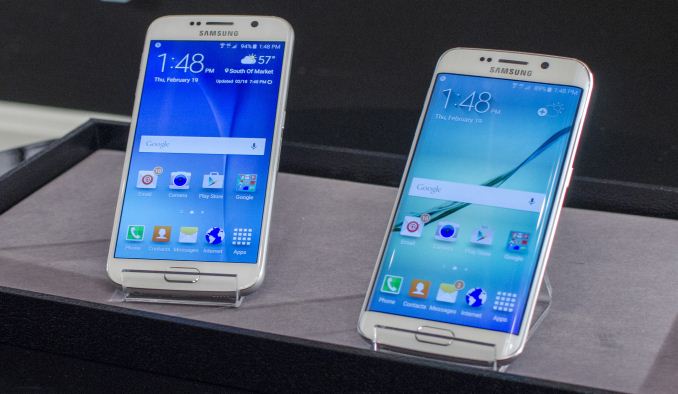
Yesterday we received our Galaxy S6 and S6 edge review units. We’re still working on the final review but I wanted to share some early results from both devices. For those that are unfamiliar with these two phones, the Galaxy S6 range represents the result of Samsung’s “Project Zero”. In fact, the phones seem to have the internal name of Zero, which can be seen in terminal, and the build properties of both devices. For Samsung, these phones represent their attempt at completely rethinking how Samsung makes phones. There is a strong emphasis on a new unibody design, which has no visible gaps or screws. Rather than the plastic that previous Samsung phones have been known for, the new design is composed of metal and glass. Samsung’s design team has been given unprecedented control throughout the process of making this phone and the result of this is a Galaxy phone that looks unlike anything else they’ve ever released.
Even if design is important, it isn’t enough to make the phone. Samsung has also outfitted the Galaxy S6 and S6 edge with their latest technologies, from a new AMOLED display to a new camera module. The specs for both phones can be seen below.
| Samsung Galaxy S5 | Samsung Galaxy S6 | Samsung Galaxy S6 Edge | |
| SoC | MSM8974ACv3 2.45 GHz Snapdragon 801 | Exynos 7420 2.1/1.5GHz A57/A53 | Exynos 7420 2.1/1.5GHz A57/A53 |
| RAM/NAND | 2GB LPDDR3 16/32GB NAND + microSD |
3GB LPDDR4-1552 32/64/128GB NAND |
3GB LPDDR4-1552 32/64/128GB NAND |
| Display | 5.1” 1080p SAMOLED HD |
5.1” 1440p SAMOLED |
5.1” 1440p SAMOLED, Dual Edge |
| Network | 2G / 3G / 4G LTE (Qualcomm MDM9x25 UE Category 4 LTE) | 2G / 3G / 4G LTE (Category 6 LTE) | 2G / 3G / 4G LTE (Category 6 LTE) |
| Dimensions | 142 x 72.5 x 8.1 mm, 145 grams | 143.4 x 70.5 x 6.8mm max, 138 grams | 142.1 x 70.1 x 7.0mm max, 132 grams |
| Camera | 16MP (5132 x 2988) Rear Facing with 1.12 µm pixels, 1/2.6" CMOS size, 31 mm (35mm effective), f/2.2 | 16MP (5132 x 2988) Rear Facing w/ OIS, f/1.9, object tracking AF | 16MP (5132 x 2988) Rear Facing w/ OIS, f/1.9, object tracking AF |
| 2MP Front Facing | 5MP Front Facing, f/1.9 | 5MP Front Facing, f/1.9 | |
| Battery | 2800 mAh (10.78 Whr) | 2550 mAh (9.81 Whr) | 2600 mAh (10.01 Whr) |
| OS | Android 4.4 w/TouchWiz |
Android 5 (64-bit) w/TouchWiz | Android 5 (64-bit) w/TouchWiz |
| Connectivity | 802.11a/b/g/n/ac 2x2 + BT 4.0 (BCM4354), USB3.0, GPS/GNSS, MHL, DLNA, NFC |
2x2 802.11a/b/g/n/ac + BT 4.1 (BCM4358), USB2.0, GPS/GNSS, NFC |
2x2 802.11a/b/g/n/ac + BT 4.1 (BCM4358), USB2.0, GPS/GNSS, NFC |
| Wireless Charging | N/A | WPC 1.1 (4.6W) & PMA 1.0 (4.2W) |
WPC 1.1 (4.6W) & PMA 1.0 (4.2W) |
| Fingerprint Sensor | Swipe | Touch | Touch |
| SIM Size | MicroSIM | NanoSIM | NanoSIM |
Both the Galaxy S6 and S6 edge have Samsung System LSI’s newest SoC, the Exynos 7420, which has a cluster of four Cortex A57s clocked at 2.1 GHz, and four Cortex A53s clocked at 1.5 GHz. Compared to the Exynos 5433 of the Galaxy Note 4, this brings a new 14nm LPE (low power early) process, an upgrade to LPDDR4 memory, and a Mali T760 GPU with two additional shader cores. Outside of the SoC, the new display is advertised to bring a higher 600-nit brightness and a higher 1440p resolution. The front and rear cameras are both different from the Galaxy S5 as well, although the rear camera sensor may be shared between the two as the camera sensors are of similar spec. For this preview, we’ll focus on the system performance and display of these new devices, but as one can see from the specification table there is far more to look at for the full review.
System Performance
For our system performance benchmarks we’ll start with our browser tests which can give a rough proxy for overall CPU performance.
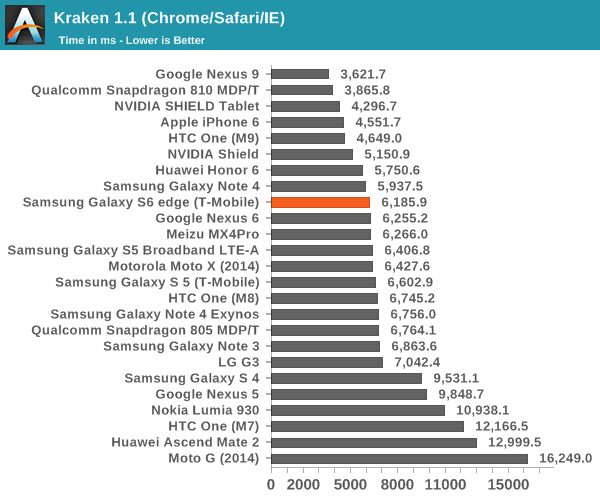
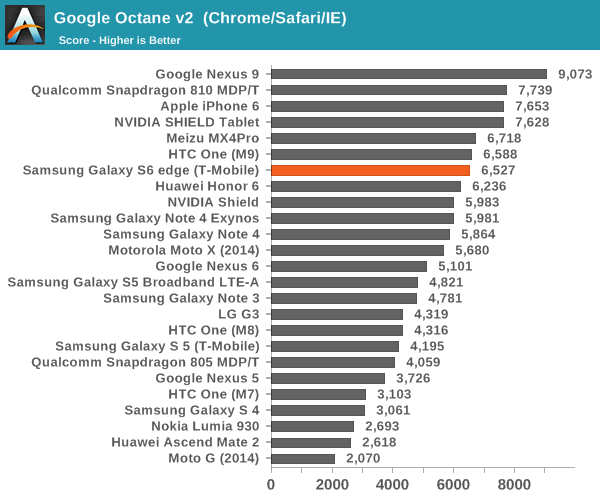
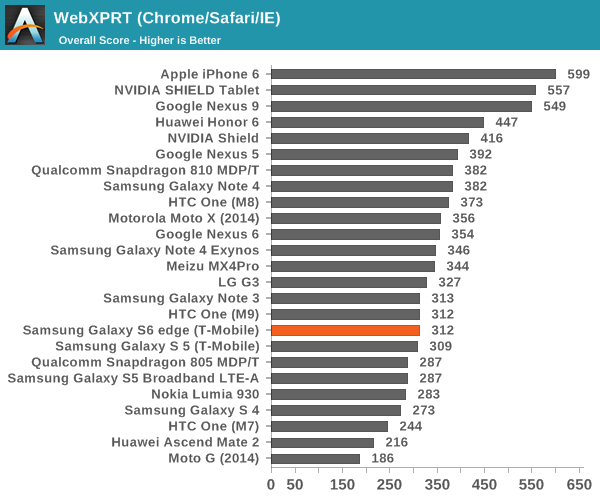
The Exynos 7420 is about on par with the Snapdragon 810 in these benchmarks. Strangely enough both tend to do worse than the Huawei Honor 6 in these tests, which clearly can't be correct. As we've previously discussed, the stock browser will often give far better results due to OEM and SoC vendor optimizations. As a part of our updates to the benchmark suite for 2015, we'll take a look at Basemark OS II 2.0, which should give a better picture of CPU performance in addition to overall device performance.
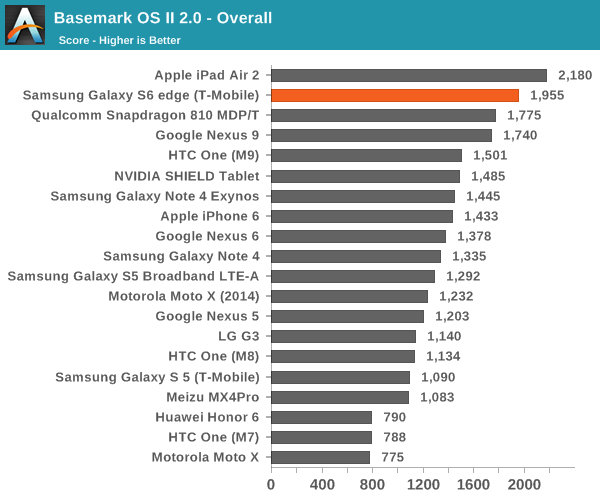
The browser benchmarks seem to hide some pretty enormous variability as the Galaxy S 6 edge (which is comparable to the Galaxy S 6) sets a new record among Android devices. The only challenger is the iPad Air 2, which uses the A8X SoC with three Enhanced Cyclone cores and the semi-custom GXA6850 GPU.
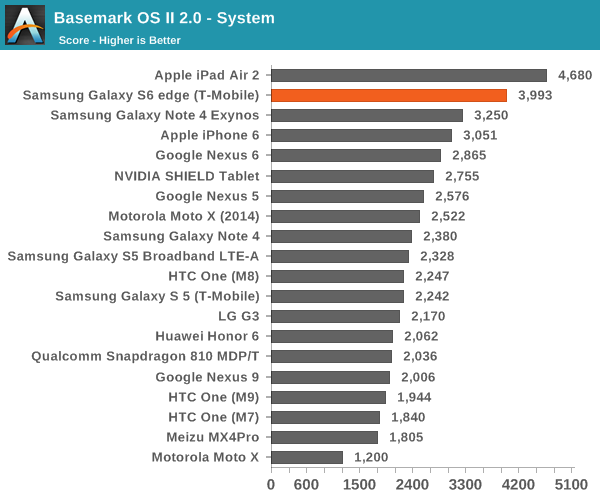
This system test contains a floating point and integer test, in addition XML parsing, which means that this test mostly stresses CPU and RAM. Interestingly enough, the Exynos 7420 pulls far ahead of both the Exynos 5433 and Snapdragon 810 in this test, and approaches the A8X. The difference between the 5433 and 7420 is likely a combination of the higher clocks on both the A57 and A53 clusters for the 7420 (1.9/1.3 on the 5433, 2.1/1.5 on the 7420), in addition to the ability to stay at a high 'overdrive' clock due to reduced leakage from the 14LPE process. The One M9 likely falls a bit short here due to HTC's governor settings restricting the use of all 8 cores simultaneously.
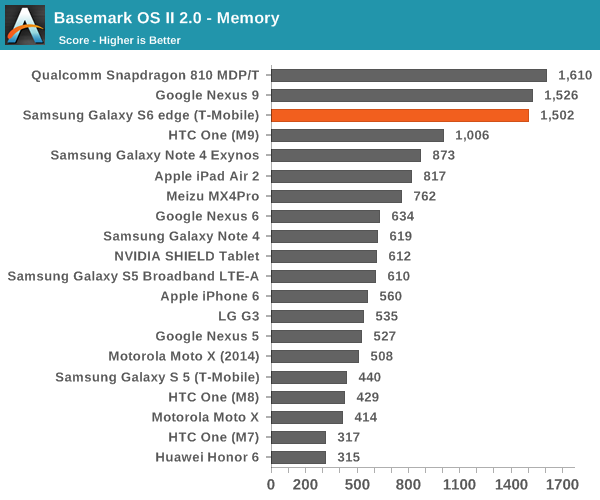
While one might guess that the memory test of 'Basemark OS II 2.0 - Memory' is of RAM, this is actually a test of the internal storage. Once again we see the S6 edge come close to leading the pack due to the use of the new UFS (Universal Flash Storage) standard. Casual examination reveals that the S6 edge has a queue depth of 16, and that it identifies itself with the rather cryptic model name of KLUBG4G1BD-E0B1.
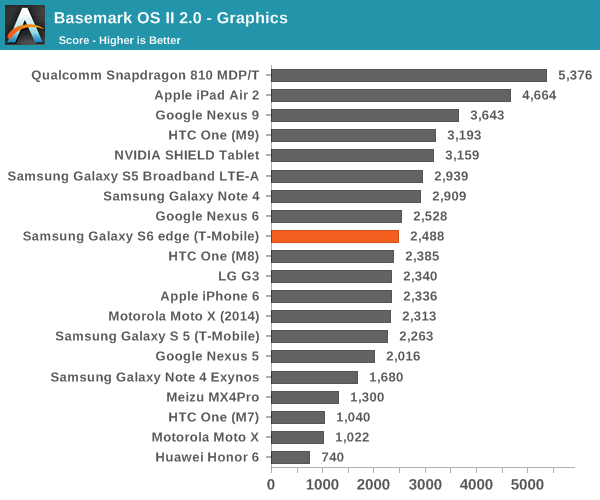
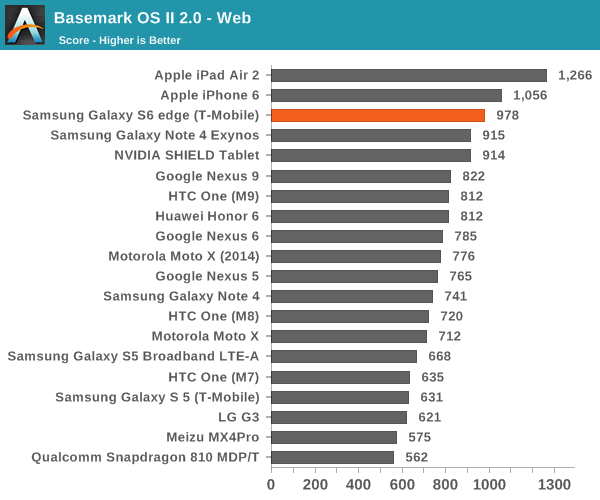
For the web test, it uses the built-in WebView rendering engine rather than Chrome and paints a distinctly different picture, especially because these tests are focused on HTML5 and CSS rather than JavaScript. Here we can see that the iPhone 6 and iPad Air 2 continue to hold their lead, but the Galaxy S6 is pretty much the king of the hill when it comes to Android devices.










200 Comments
View All Comments
Bluetooth - Sunday, March 29, 2015 - link
Actually the battery and memory leaks have not been fixed in 5.1 (http://www.androidstandard.com/android-5-1_r3-chan... Hopefully they will be fixed soon or before the one year release birthday of Lollipop.Kidster3001 - Wednesday, April 1, 2015 - link
I got 4 to 5 days of battery life on Nexus 6 with 5.0.1. It dropped to 1 day if I left wifi on all the time. With 5.1 I don't see much difference.Frenetic Pony - Thursday, March 26, 2015 - link
Impressed? The CPU benchmarks aren't any big thing over the S5, the screen (as has been stated many times) has a useless resolution upgrade, the phone has lost the removable battery and SD card slot, and if you wanted a unibody design odds are you bought a G3/M8/Iphone a while ago and are happy with it.This phone seems like a step sideways with no new features to speak of, then again so does the HTC M9.
robertkoa - Thursday, March 26, 2015 - link
You have a point in terms of raw specs...If you took an S5 with 3 Gigs of faster RAM and streamlined Touchwiz- you might be here i Benchmarks but....
In the Future I' d like to see scaleable screen Res. So you could go from 1080p to 2 HD in Settings depending on needs....
josephnero - Friday, March 27, 2015 - link
and also it isn't waterproof anymore.check these battery resaultshttp://www.gsmarena.com/samsung_galaxy_s6-review-1...
http://www.gsmarena.com/sony_xperia_z3-review-1140...
wolrah - Thursday, March 26, 2015 - link
How in the world is it that bad? My S4 is closing in on two years old and still easily gets me through an entire day most days. I'm not running any silly battery life hacks, all radios are fully enabled all the time and the only "Battery Saver" functionality I use is the Lollipop standard one that prompts at 15% charge. I unplug at around 9 AM when I head down to my office and my phone generally doesn't see power again until I go to bed unless I need to drive to a customer site, in which case it gets a mere 500mA "USB" charge from my car that isn't even enough to maintain charge while using GPS.As much as I theoretically love the idea of a replaceable battery, I've had it on my last three phones and never actually used the capability. Expandable memory on the other hand I've used on every single phone I've ever had, so that's my big problem with the S6. Until we see phones where 128GB is the small storage option I won't give up on the MicroSD slot.
bernstein - Thursday, March 26, 2015 - link
easy. battery wear fluctuates wildly, at least when measuring after >600 rechcharge cycles. his obviously is eol, while you got lucky... fyi i have not seen many smartphone batteries last more than three years, since people tend to sell/hand-down older flagship phones battery replacements on those are fairly common. a bit more expensive with non-removal batteries but even at $90 its still a bargain to freshen up a two year old flagship...theduckofdeath - Thursday, March 26, 2015 - link
When I sold my 1½ year old S4 I couldn't tell the difference in battery life from when it was new. You're one of those typical trolls by any chance, who's actually never held a Samsung phone? The fact that you clearly had were so eager to get firsties with this comment makes me pretty suspicious. Prepared FUD?theduckofdeath - Thursday, March 26, 2015 - link
Sorry, not "you", the OP... :Dcknobman - Friday, March 27, 2015 - link
LOL "mine works fine therefore you're a liar!!"Love that line of immature rationality. Yes we actually own Samsung devices (GS3, GS4) and yes the batteries do go bad.
Apparently you have no clue how Lithium-ion battery technology works. Go look it up and do some research before you blindly call people trolls.